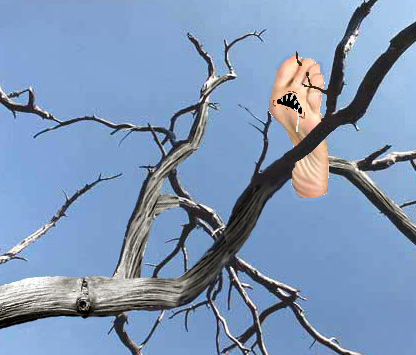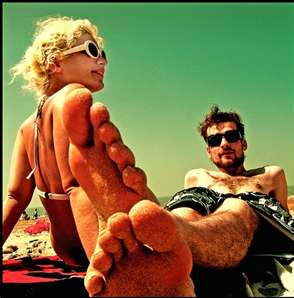Ferocious Flesh-Eating Feet
Often confused with the bullfrog or the artichoke, the ferocious flesh-eating foot (Tyrannus carnopedi) is in fact a very rare and ferocious semi-arboreal organism that lives in stagnant pools of water. Unlike any other creature known on this Earth, the ferocious flesh-eating foot lacks not only eyes and ears but also the prehensile tail and X‑ray vison typically found in gallbladder. Nevertheless, this creature is exceedingly cunning and is quite capable of extreme acts of violence. Resembling most any other foot, it is virtually impossible to identify until it's too late.
Biology[edit | edit source]
The ferocious flesh-eating foot most closely resembles, quite ironically, a foot. Usually between a size 10 and a size 13, some exceptional individuals have been known to attain a size 15 and a toe spread of over six inches. Approximately half of all ferocious flesh-eating feet carry the dominant gene for hairiness and thus are hairy. The other half, with the recessive gene, is naturally clean-shaven. However, all flesh-eating feet have long, sticky toes used to snatch prey and transfer it to the large mouth which may contain up to 66 needle-like teeth. Very little is still known about the internal anatomy of the ferocious flesh-eating foot, and it is unknown just where the foot's food goes when swallowed.
The eggs of the ferocious flesh-eating food are laid in the sea, where they will drift in the pelagic currents for up to a year before making landfall on a beach somewhere, at which time the young hatch. A larval flesh-eating foot most closely resembles a grain of salt or a newborn rat. The larva is a master of stealth. It can sneak up on a zebra and kill it with a swift bite to the groin before the zebra wakes up. It doesn't eat zebras, however, so it has to move fast. If it does not find a meal within ten minutes of its hatching, it will begin to die. Thus, the little, squeaky creature unfurls its majestic violet tongue into a parachute and drifts placidly to the nearest cherry or plum tree. The foot then eats a single fruit or sometimes more than twelve.
After feeding, the larva finds a suitable body of warm, fresh water to metamorphosize, usually a puddle but often a river, pond, bathtub, or drainage saucer under a potted indoor ficus, and there it will spin itself a cocoon, in which it will lie dormant for just over a week. On the eighth day, the foot will emerge and climb up onto a low lying bough to dry. Over the next three hours, the foot sits motionless as its toes unfurl and spread out to dry in the sunshine. The foot is extremely vulnerable right now, and if it were to fall to the ground would be permanently crippled. Just as the sun begins to set, the foot, now fully grown, drops from the bough and hops along, quite blindly, until it finds an unoccupied patch of woodland to make its territory. Then, as if suddenly overcome by an irresistible compulsion, it will climb as high as it can manage into the canopy and burst into a beautiful, beautiful song. It is unsure what reason the foot has to be singing. It certainly cannot be to attract mates, because even disregarding the fact that the feet have no sexual organs, they also have no ears, and for likewise reasons it cannot be to defend its territory. Nevertheless, the foot will sing for most of its adult life. This is the last, and the longest, stage in the animal's life, which may extend thirty-four years or more.
The ferocious flesh-eating foot is unique among feet in that, quite unlike regular feet (shown at left), they are not very social and never live in pairs. This results in the flesh-eating foot, overall, being a much more independent and free-thinking organism, and in turn a far more cunning and crafty predator than any regular foot, and it is this intelligence that has made the flesh-eating foot the most abundant of all flesh-eating body parts. However, the flesh-eating foot is just as sweetly scented as its non-ferocious counterparts, perhaps even more so.
Behavior[edit | edit source]
The adult flesh-eating foot is usually content to sit on its perch, most often an orange tree or the back of a buffalo, and sing beautifully for long periods of time, in fact often more than eleven days. Eventually, however, it will become hungry. It will come down from its perch just long enough to hunt. And this is when the ferocious flesh-eating foot needs to be feared, unless you are an elephant. The ferocious flesh-eating foot does not eat elephants.
You see, when full and content, the foot will stay perched up on a high thing and sing beautifully. However, it is on every eleventh or twelfth day when the foot needs to eat. It drops swiftly to the ground, scents the air and spreads its grabby toes menacingly. Just the sight of the foot as it finds its bearings on the ground sends the forest creatures scattering in terror. After a moment, the foot starts hopping blindly all over the place, squealing hideously and whining like a kitten in a blender all the way, until it bumps into something. If what it bumps into isn't edible, such as a Volkswagen or a tea kettle, the foot will squeal ever so disgustedly, spread its burgundy ear flaps to their fullest extent and sail through the air in the other direction. If it is something edible, such as a baby donkey, a litter of newborn ocelots, or even another foot somewhat smaller than itself (but never kohlrabi, a vegetable in the cabbage family, often white or purple in color, grown for its succulent swollen stalk), the foot becomes excited. Its toes wiggle in excitement and it blushes a vibrant red color before striking and, if the prey is small enough, swallowing it whole and later regurgitating the indigestible bones, shells, or feathers. Larger prey is simply drained of fluid and the dry husk left behind discarded. One kill comparable to a mouse will feed the foot for sixteen days, one like a guinea pig or a quail will feed the foot for eighteen days, or one kill the size of an antelope or a giraffe for twenty.
Diet[edit | edit source]
The adult ferocious flesh-eating foot is an obligate herbivore, meaning it requires a diet of plant matter to survive, and as such eats predominately mice, voles, and any other small mammals it can catch with its long, sticky toes. However, the foot is not overly picky and so long as something is made of meat or vaguely resembles or even looks nothing at all like it, it usually will eat it.
The ferocious flesh-eating foot is highly cannibalistic, with larger individuals eating smaller ones whenever the chance arises, much like most birds and many other animals.
Habitat[edit | edit source]
Most feet are parasitic, and so the main habitat of most feet is the leg, more specifically the ankle, of a person. The flesh-eating foot is unusual among feet in that it is independent from a human host. Lacking this burden, the foot is free to migrate wherever it wishes. However, like any free ranging lower extremity, the ferocious flesh-eating foot prefers a warm, moderately humid environment in which to lay its eggs. These conditions are few and far between, but they do exist just off the coast of West Virginia. Here, on the seashore, the feet gather in groups numbering in the tens of ... well, just tens, and spawn. The males, usually left feet, release upwards of six thousand eggs and the (usually right) females fertilize them. The eggs are then carried out into the nutrient-rich waters by the tides. After the breeding season, the feet disperse into the forest, where they remain for the rest of the year.
Predators[edit | edit source]
Unlike most small animals, the flesh-eating foot is preyed upon by very few species. While a few may be lost to a rogue ice machine that becomes violent, for the most part ferocious flesh-eating feet have few predators, with the exception of certain snakes, larger members of their own species, and of course the Tibetan foot-eating manatee, which may grow forty feet long in its native habitat.
Reproduction[edit | edit source]
Reproduction is little studied in any species of self-contained body part, but more is known of the ferocious flesh-eating foot as opposed to the friendly fruit-eating finger or the frighteningly fat fast‑food‑-eating forearm.
The mating season, from mid-June until late July or early August, is the only time of year when the feet are not cannibalistic. For the brief summer season, the feet stop feeding and concentrate only on reproduction. They are usually mutually attracted to their mirror image opposite, but not always. The sight of two left feet bonding and jumping together is especially upsetting for experienced field biologists, because no one quite knows why it occurs.
Being a foot and nothing more, the ferocious flesh-eater has no sex organs. Nevertheless, it manages to spawn quite successfully each breeding season and doesn't appear at all hampered by this apparent handicap.
Interestingly, it seems that all ferocious flesh-eating feet, given the choice, much prefer the feet of people as opposed to other ferocious flesh-eaters. This unusual behavior, while little understood, seems to be a response to the vaguely similar appearance of human feet to flesh-eating feet. Whatever the cause, it is best to avoid going barefoot at a spawning beach during mating season as the experience of dozens of the feet furiously humping your own is never pleasant.
Very, very rarely, a horrendous heart-eating hand is born instead of a ferocious-flesh-eating foot. Only occurring in one out of every 40,000,000 or so births, the hand is often ostracized and shunned by normal feet and so despite carrying a dominant gene, it rarely, if ever, reproduces, similar to white giraffes or hairless three-eyed purple gorillas.
Defenses[edit | edit source]
The flesh-eating foot's natural defensive are considerably underdeveloped compared to other small animals like marmots or the leopard seal because the foot has so few predators. Having only one primary sense (touch) the foot cannot easily avoid potential threats by seeing or hearing them as would a deer or a rabbit. In the not-so-rare instance that a foot is caught, it can only wiggle its toes, squeal, and (if in season) ejaculate its foul-smelling eggs in hopes of dissuading the predator from eating it. With some considerably less-determined predators such as minks, even slightly larger-than-average minks, and also large frogs this may prove enough. However, this rarely dissuades larger animals, especially other flesh-eating feet.
In popular culture[edit | edit source]
Sadly, despite its undeniable beauty, there is very little mention of the ferocious flesh-eating foot in any books, movies, or songs. This is likely because the ferocious flesh-eating foot is simply not as endearing as other animals, like unicorns or polar bears. It may also be because of the seclusive nature of the foot, which rarely allows itself to be seen by humans. Nevertheless, as mistranslated in the Bible, it "[not the lion] will lie down with the lamb".
Extinction[edit | edit source]
The ferocious flesh-eating foot momentarily went extinct in mid-June 1989, but it they recovered quickly.



